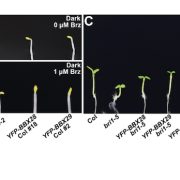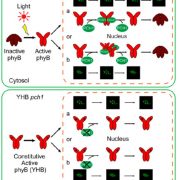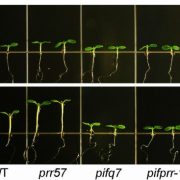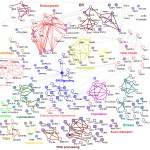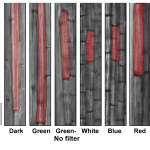Underwater blues: Molecular rewiring of stomatal development in Rorippa aquatica
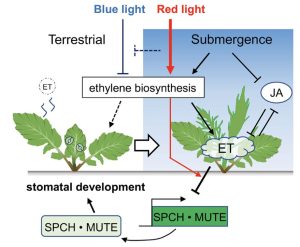 Unanticipated flooding conditions challenge the survival and overall growth and development of a plant, for example stomatal development is suppressed under submerged conditions. Stomata are microscopic pores on the surface of leaves of a plant that play an important role in the exchange of gases between the plant and the atmosphere. Ikematsu et al. outline a molecular framework underlying the inhibition of stomatal development under water by using an amphibious plant Rorippa aquatica, an emerging model in the Brassicaceae family. Rorippa aquatica produces different leaf forms (heterophylly) when submerged as opposed to in dry air, with the submerged leaves also showing fewer stomata. Their findings suggest that submergence-triggered inhibition of stomata can be uncoupled from morphological heterophylly. Upon submergence there is reprogramming of a suite of genes underlying light signaling and hormones, eventually repressing the stomatal developmental genes SPCH and MUTE. The authors found that blue light promotes, whereas red light inhibits, stomatal development. Their results indicate that in these plants there has been a rewiring of the pathway from red light to ethylene. (Summary by Arpita Yadav @arpita_yadav_). Curr. Biol. 10.1016/j.cub.2022.12.064
Unanticipated flooding conditions challenge the survival and overall growth and development of a plant, for example stomatal development is suppressed under submerged conditions. Stomata are microscopic pores on the surface of leaves of a plant that play an important role in the exchange of gases between the plant and the atmosphere. Ikematsu et al. outline a molecular framework underlying the inhibition of stomatal development under water by using an amphibious plant Rorippa aquatica, an emerging model in the Brassicaceae family. Rorippa aquatica produces different leaf forms (heterophylly) when submerged as opposed to in dry air, with the submerged leaves also showing fewer stomata. Their findings suggest that submergence-triggered inhibition of stomata can be uncoupled from morphological heterophylly. Upon submergence there is reprogramming of a suite of genes underlying light signaling and hormones, eventually repressing the stomatal developmental genes SPCH and MUTE. The authors found that blue light promotes, whereas red light inhibits, stomatal development. Their results indicate that in these plants there has been a rewiring of the pathway from red light to ethylene. (Summary by Arpita Yadav @arpita_yadav_). Curr. Biol. 10.1016/j.cub.2022.12.064



